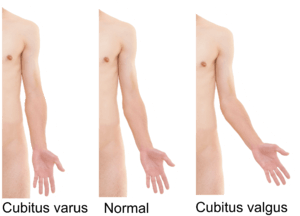Varus deformity
| Varus deformity | |
|---|---|
| Classification and external resources | |
| Specialty | rheumatology |
| ICD-10 | M21.1 |
In orthopedics, a varus deformity is a term for the inward angulation of the distal segment of a bone or joint. The opposite of varus is called valgus.
The terms varus and valgus always refer to the direction that the distal segment of the joint points.
For example, in a valgus deformity of the knee, the distal part of the leg below the knee is deviated outward, resulting in a knock-kneed appearance. Conversely, a varus deformity at the knee results in a bowlegged appearance, with the distal part of the leg deviated inward.
Terminology
The terminology is made confusing by the etymology of these words.
- In the original Latin, the definitions are the opposite of current usage. Valgus actually means "knocked-kneed"[1][2] and varus, "bow-legged".[3][4]
- Application of these words in adjectival form to other portions of the body by the medical community has resulted in their definitions changing so that they now refer to the angle of the distal segment (i.e. valgus impaction in a Garden I femoral neck fracture).
- It is correct for a knock-kneed deformity to be called both a varus deformity at the hip (coxa vara) and a valgus deformity at the knee (genu valgum); although the common terminology is to simply refer to it as a valgus knee.
When the terminology refers to a bone rather than a joint, the distal segment of the bone is being described. Thus, a varus deformity of the tibia (i.e. a mid-shaft tibial fracture with varus deformity) refers to the distal segment in a varus alignment compared to the proximal segment.
Examples
- Hip: coxa vara — the angle between the head and the shaft of the femur is reduced, resulting in a limp.[5]
- Knee: genu varum (from Latin genu = knee) — the tibia is turned inward in relation to the femur, resulting in a bowlegged deformity.
- Ankle: talipes equinovarus (from Latin talus = ankle and pes = foot) — inward turning of the heel, resulting in clubfoot with the person walking on the outer part of the foot.
- Toe: hallux varus (Latin hallux = big toe) — inward deviation of the big toe away from the second toe.
- Elbows: cubitus varus (Latin cubitus = elbow) — turned inward elbows
See also
References
| Wikimedia Commons has media related to Varus deformity. |
- ↑ "valgus. Charlton T. Lewis, Charles Short, A Latin Dictionary".
- ↑ Harvard University Dept. of the Classics: Harvard Studies in Classical Philology, Volume 8, page 109. Ginn & Company, 1897.
- ↑ "varus. Charlton T. Lewis, Charles Short, A Latin Dictionary".
- ↑ Harvard University Dept. of the Classics: Harvard Studies in Classical Philology, Volume 8, page 109. Ginn & Company, 1897.
- ↑ "Congenital Coxa Vera: eMedicine Orthopedic Surgery".
- Canale & Beaty: Campbell's Operative Orthopaedics, 11th ed. - 2007 - Mosby, An Imprint of Elsevier
